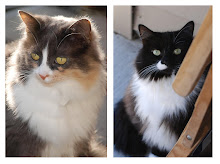That is the question.......
Actually, I suspect the question right now is, what is HDR?
First of all, lets get the "nerd alert" out of the way, since this post may start to get a little nerdy. Instead of getting all technical, let's have a look at two photos and then you can tell me what you think.
 |
| The Mittens, Monument Valley - 1 exposure, no HDR |
 |
| The Mittens, Monument Valley - 5 exposures, HDR |
The question is, do you like the effect that you almost inevitably get when you HDR a photo?
Here are a couple more to compare:
 |
| Dead Horse Point State Part, Utah - 1 exposure, no HDR |
 |
| Dead Horse Point State Part, Utah - 5 exposures, HDR |
The HDR photo has more detail, but it also seems to end up somewhat cartoony and artificial. I still can't decide if I like it or not.
What about you?






9 comments:
I have to say I like HDR better from an artistic point of view. It may look artificial, but photographers have been using graduated neutral density filters and other manual techniques to get a better white balance years before digital postprocessing became popular.
Isn't this the technology that the iPhone uses? I don't know much about it, but I'm sure that I read that's how it manages to take such great shots.
As to which I prefer, I think it would depend on the subject. In your two examples, if I were wanting a photo to hang on the wall as a piece of art, I'd prefer the HDR version.
I haven't seen any of people or animals, but I suspect I would like the HDR version less. Might work quite well for insects though, and bring out some of the wonderful detail and colours quite well.
I do like the HDR better. I was disappointed when I read Jay's comment though........... I was thinking this might improve my Nexus portrait! No such luck I guess.
Tim: Good point - what is a "real" photograph?
Jay: Don't know nothing about iPhones, since I only just have a bog-standard cell phone. HDR won't really work well with people or animals, unless you can get them to sit still long enough to get 3 or 5 exposures off before they move. You can use tone-mapping though. Really don't know how this works, but it does use only one exposure and it gives similar results to HDR. Perhaps that is what the iPhone is doing?
Cortes: Are you sure you want to bring out all the details of your face?
I have mixed feelings. I think with a static subject, I'd rather just take the 'perfect' shot. It's too easy to enhance, HDR, photoshop, whatever. But if you have a pic that needs a little enhancement for an aesthetic reproduction or just so it looks nicer... go for it. Still my mission to take the perfect pic in natural ligh.I do use a UV filter on sunny days though. Jay's sort of right. IPhone has an Instagram app that enriches but also gives an antique look so not quite the same as HDR or mucking around with white balance, saturation etc. Frankly, I just wanna be put in the picture!
Sometimes I do like HDR photos. Not always though. Very much depending on the subject and the end result. Same goes for high-key and low-key shots. Not always a success, but sometimes beautiful.
So... that didn't make you any wiser ;-)
Baino: Ah yes, the perfect shot. I do agree with you, but sometimes the light just won't allow it, particularly if you have a wide range of lights to darks. As for being in the shot - the stage is all yours! I hate having my photo taken.
Carolina: I am always wiser after your comments - you just echoed my own thoughts. Sometimes it works, sometimes it doesn't, it just depends on the shot and the person looking at the photo.
Ah, that is the burning question. From an artist's point of view, boosting the exposure of the dark/ shadow areas is very useful, and I've done it for years for reference images, because, of course, then I can see what's in them! And pushing up the contrast makes images look exciting and vibrant - the art term is 'high key palette'.
However used without discernment, on all images, leads to a sameness about everything, and a lack of variety of mood. Sometimes I want my shadows (or back-ground, or textile folds) to be dark, or unclear, often for the purposes of enhancing a focal point, or creating emphasis.
So yeah, my input: 'It depends'.
Post a Comment